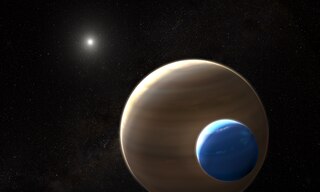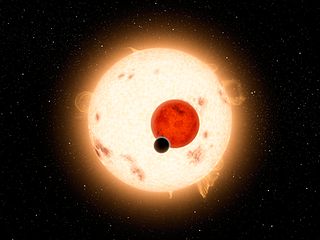
An exoplanet or extrasolar planet is a planet outside the Solar System. The first possible evidence of an exoplanet was noted in 1917 but was not then recognized as such. The first confirmation of the detection occurred in 1992. A different planet, first detected in 1988, was confirmed in 2003. According to statistics from the NASA Exoplanet Archive, As of 17 October 2024, there are 5,780 confirmed exoplanets in 4,314 planetary systems, with 969 systems having more than one planet. The James Webb Space Telescope (JWST) is expected to discover more exoplanets, and to give more insight into their traits, such as their composition, environmental conditions, and potential for life.

An exomoon or extrasolar moon is a natural satellite that orbits an exoplanet or other non-stellar extrasolar body.
A Kepler object of interest (KOI) is a star observed by the Kepler space telescope that is suspected of hosting one or more transiting planets. KOIs come from a master list of 150,000 stars, which itself is generated from the Kepler Input Catalog (KIC). A KOI shows a periodic dimming, indicative of an unseen planet passing between the star and Earth, eclipsing part of the star. However, such an observed dimming is not a guarantee of a transiting planet, because other astronomical objects—such as an eclipsing binary in the background—can mimic a transit signal. For this reason, the majority of KOIs are as yet not confirmed transiting planet systems.

Kepler-16b is a Saturn-mass exoplanet consisting of half gas and half rock and ice. It orbits a binary star, Kepler-16, with a period of 229 days. "[It] is the first confirmed, unambiguous example of a circumbinary planet – a planet orbiting not one, but two stars," said Josh Carter of the Center for Astrophysics | Harvard & Smithsonian, one of the discovery team.

Planet Hunters is a citizen science project to find exoplanets using human eyes. It does this by having users analyze data from the NASA Kepler space telescope and the NASA Transiting Exoplanet Survey Satellite. It was launched by a team led by Debra Fischer at Yale University, as part of the Zooniverse project.

Kepler-47c is an exoplanet orbiting the binary star system Kepler-47, the outermost of three such planets discovered by NASA's Kepler spacecraft. The system, also involving two other exoplanets, is located about 3,400 light-years away.

The Hunt for Exomoons with Kepler (HEK) is a project whose aim is to search for exomoons, natural satellites of exoplanets, using data collected by the Kepler space telescope. Founded by British exomoonologist David Kipping and affiliated with the Center for Astrophysics | Harvard & Smithsonian, HEK submitted its first paper on June 30, 2011. HEK has since submitted five more papers, finding some evidence for an exomoon around a planet orbiting Kepler-1625b in July 2017.

Kepler-90, also designated 2MASS J18574403+4918185, is a F-type star located about 2,790 light-years (855 pc) from Earth in the constellation of Draco. It is notable for possessing a planetary system that has the same number of observed planets as the Solar System.

Kepler-90h is an exoplanet orbiting within the habitable zone of the early G-type main sequence star Kepler-90, the outermost of eight such planets discovered by NASA's Kepler spacecraft. It is located about 2,840 light-years, from Earth in the constellation Draco. The exoplanet was found by using the transit method, in which the dimming effect that a planet causes as it crosses in front of its star is measured.

Kepler-90g is a super-puff exoplanet orbiting the early G-type main sequence star Kepler-90, one of eight planets around this star discovered using NASA's Kepler space telescope. It is located about 2,840 light-years (870 pc) from Earth, in the constellation Draco. The exoplanet was found by using the transit method, in which the dimming effect that a planet causes as it crosses in front of its star is measured. It orbits its parent star about every 210.5 days at a distance of 0.71 astronomical units.

Kepler-138, also known as KOI-314, is a red dwarf located in the constellation Lyra, 219 light years from Earth. It is located within the field of vision of the Kepler spacecraft, the satellite that NASA's Kepler Mission used to detect planets transiting their stars.

Kepler-438b is a confirmed near-Earth-sized exoplanet. It is likely rocky. It orbits on the inner edge of the habitable zone of a red dwarf, Kepler-438, about 460.2 light-years from Earth in the constellation Lyra. It receives 1.4 times our solar flux. The planet was discovered by NASA's Kepler spacecraft using the transit method, in which the dimming effect that a planet causes as it crosses in front of its star is measured. NASA announced the confirmation of the exoplanet on 6 January 2015.
Kepler-419c is a super-Jupiter exoplanet orbiting within the habitable zone of the star Kepler-419, the outermost of two such planets discovered by NASA's Kepler spacecraft. It is located about 3,400 light-years from Earth in the constellation Cygnus. The exoplanet was found by using the transit timing variation method, in which the variations of transit data from an exoplanet are studied to reveal a more distant companion.

Kepler-1647b is a circumbinary exoplanet that orbits the binary star system Kepler-1647, located 3,700 light-years (1,100 pc) from Earth in the constellation Cygnus. It was announced on June 13, 2016, in San Diego at a meeting of the American Astronomical Society. It was detected using the transit method, when it caused the dimming of the primary star, and then again of the secondary star blended with the primary star eclipse. The first transit of the planet was identified in 2012, but at the time the single event was not enough to rule out contamination, or confirm it as a planet. It was discovered by the analysis of the Kepler light-curve, which showed the planet in transit.
Kepler-1625 is a 14th-magnitude solar-mass star located in the constellation of Cygnus approximately 7,200 light-years away. Its mass is within 5% of that of the Sun, but its radius is approximately 70% larger reflecting its more evolved state. A candidate gas giant exoplanet was detected by the Kepler Mission around the star in 2015, which was later validated as a real planet to >99% confidence in 2016. In 2018, the Hunt for Exomoons with Kepler project reported evidence for a Neptune-sized exomoon around this planet, based on observations from NASA’s Kepler mission and the Hubble Space Telescope. Subsequently, the evidence for and reality of this exomoon candidate has been subject to debate.
Kepler-1625b is a super-Jupiter exoplanet orbiting the Sun-like star Kepler-1625 about 2,500 parsecs away in the constellation of Cygnus. The large gas giant is approximately the same radius as Jupiter, and orbits its star every 287.4 days. In 2017, hints of a Neptune-sized exomoon in orbit of the planet was found using photometric observations collected by the Kepler Mission. Further evidence for a Neptunian moon was found the following year using the Hubble Space Telescope, where two independent lines of evidence constrained the mass and radius to be Neptune-like. The mass-signature has been independently recovered by two other teams. However, the radius-signature was independently recovered by one of the teams but not the other. The original discovery team later showed that this latter study appears affected by systematic error sources that may influence their findings.

In astronomy, a disrupted planet is a planet or exoplanet or, perhaps on a somewhat smaller scale, a planetary-mass object, planetesimal, moon, exomoon or asteroid that has been disrupted or destroyed by a nearby or passing astronomical body or object such as a star. Necroplanetology is the related study of such a process.

Kepler-1625b I is a possible moon of exoplanet Kepler-1625b, which may be the first exomoon ever discovered, and was first indicated after preliminary observations by the Kepler Space Telescope. A more thorough observing campaign by the Hubble Space Telescope took place in October 2017, ultimately leading to a discovery paper published in Science Advances in early October 2018. Studies related to the discovery of this moon suggest that the host exoplanet is up to several Jupiter masses in size, and the moon is thought to be approximately the mass of Neptune. Like several moons in the Solar System, the large exomoon would theoretically be able to host its own moon, called a subsatellite, in a stable orbit, although no evidence for such a subsatellite has been found.

TOI-2180 b is a giant exoplanet orbiting the G-type star TOI-2180, also known as HD 238894. It was discovered with the help of the Transiting Exoplanet Survey Satellite and is currently the exoplanet with the longest orbital period TESS was able to uncover. TOI-2180 b orbits its host star every 260.16 days.


















